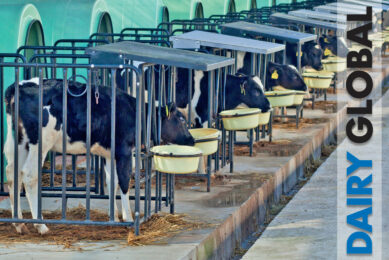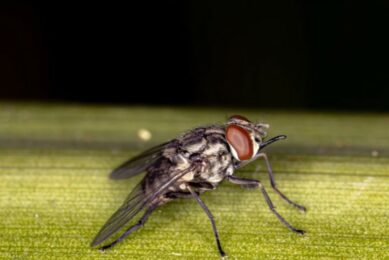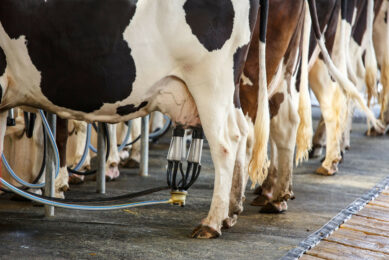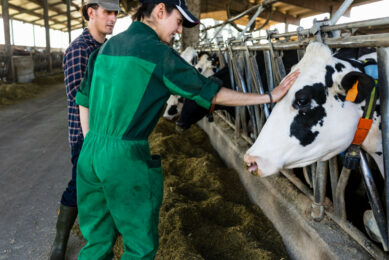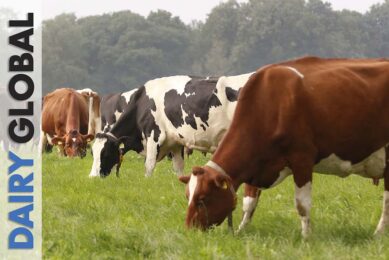Mastitis is an infectious disease resulting in an inflammatory reaction in the mammary gland of the cow. The pathogens that cause mastitis include bacteria such as; Staphylococcus aureus, coagulase-negative staphylococcus, Streptococcus uberis, Streptococcus dyslactiae, Streptococcus agalactiae, enterococci and coliform bacteria including Escherichia coli and Mycoplasmas. A cow can be infected by either acquiring the bacteria from the environment or through the transmission of contagious bacteria from cow to cow during the milking process. This disease has a clearly visible clinical form with inflammation and affected milk and a sub-clinical form, where the cow does not show any visible signs of infection on the udder or abnormalities in the milk.
Mastitis
Mastitis is one of the most detrimental diseases in the dairy sector. The disease costs the US dairy industry about US$1.7 to 2 billion each year alone, about $200 per infected cow.
Mastitis causes inflammation and swelling of the udder, resulting in a cow that is clearly sick, feverish and depressed. The infection leads to inconsistency of the milk, which will often develop clots or change colour.
Subclinical mastitis does not cause any visible signs in the cow or in the milk. But the somatic cell count will be higher than normal.
Mastitis adversely affects the reproductive performance of dairy cows. On average it takes 40 days longer to impregnate cows that have had a case of mastitis compared to herd mates that had not.
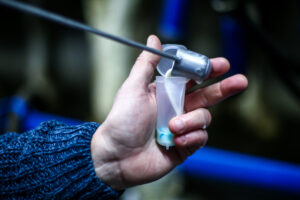
Diagnosis of mastitis is made on clinical signs of abnormal milk, swelling of the udder and general signs of illness such as; fever, depression, loss of appetite and in many cases a reduced milk production.
Subclinical mastitis is not visible to the naked eye in individual cows. Cows with subclinical mastitis have an increased cell count. Milk production is lower than normal. The individual somatic cell count is determined during the periodic milk check. The somatic cell count is a measure of the health of the udder. A healthy cow has a fairly constant (low) somatic cell count during lactation, which can increase slightly at the end of lactation. The presence of bacteria in the udder or injuries to the quarter or teat increase the number of white blood cells in the milk. The norm for an increased cell count is a count higher than 200,000 cells per ml.
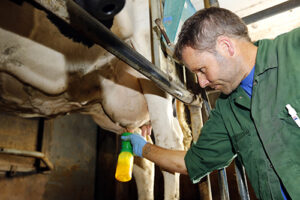
Prevention of mastitis comes down to good management practices. It starts with clean milking equipment and goes all the way to animal and herd management. The milking equipment should be functional and well maintained. During milking teat dipping, pre- and post-milking with an effective, approved teat dip should be standard practice. Clinical cases should be treated as early as possible and cows with chronic mastitis should be culled to prevent spread within the herd.
Vaccinations
Vaccinations for mastitis are available, but as they only reduce the severity of the condition, and cannot prevent reoccurring infections, they should be used in conjunction with a mastitis prevention programme.
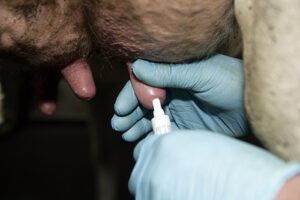
Treatment
Treatment is possible with antibiotics, but milk from such cows is not marketable until drug residues have left the cow’s system. Antibiotics can be systemic (injected into the body), or forced upwards into the teat through the teat canal (intramammary infusion). A prerequisite for a successful treatment is that the causative bacteria is sensitive to the antibiotics used. A sensitivity test provides a definite answer.



